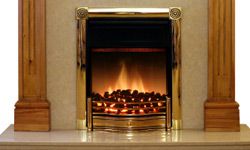Your fireplace needs regular care and cleaning to assure a safe and efficient fire. Creosote, a flammable tarlike substance that accumulates in the chimney and flue, should be removed by a professional, eliminating the worry of at least one potential fire hazard.
Give your fireplace and its accessories routine cleaning throughout the wood-burning season to eliminate an accumulation of soot, ashes, and creosote tars.
Advertisement
Here are several cleaning suggestions:
- Vacuum or dust the hearth area weekly to prevent dust and soot buildup. Do not sweep or vacuum until all the embers have been extinguished for at least 12 hours.
- Burn only seasoned, well-dried wood to minimize dangerous creosote buildup.
- Inspect the firebox, flue, and chimney annually for creosote accumulation.
- Do not use water to drown a fire unless there is an emergency. It will make a paste of the ashes, which is difficult to remove.
- Never use an abrasive cleanser inside the fireplace. Many leave a flammable residue.
- When cleaning your fireplace, sprinkle damp coffee grounds over the cooled ashes to keep down the dust.
With those tips in mind, let's go into more detail about cleaning the different parts of your fireplace:
Advertisement
